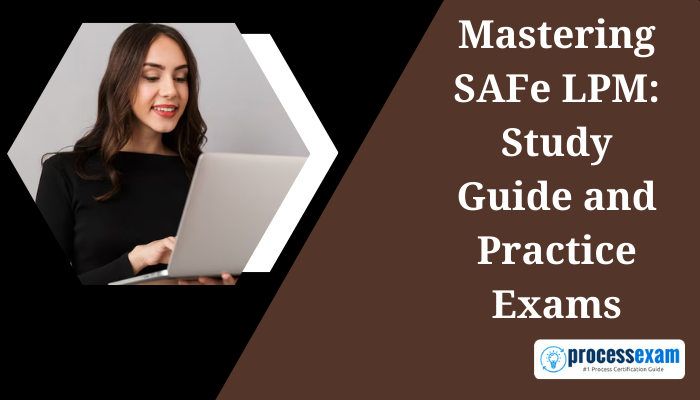
LPM or the Certified SAFe Lean Portfolio Management certification is a prestigious credential that validates your expertise in aligning strategy and execution using lean principles. Preparing for the certification requires a structured approach, combining effective study techniques with rigorous practice. This guide provides some essential study tips and compelling reasons to use practice tests, helping you achieve success in your SAFe LPM certification journey.
What Can You Do with Lean Portfolio Management?
Aligning strategy with execution is essential for an organization's success and a fundamental component of the Scaled Agile Framework (SAFe). By adopting a Lean Portfolio Management (LPM) approach, you can foster cross-functional collaboration, empower teams, and focus on delivering value, enabling quicker adaptation to customer needs.
The Lean Portfolio Management course equips executives, project management officers (PMOs), and other key stakeholders with the skills to plan dynamically and adjust initiatives and budgets in response to market changes. The LPM certification offers the necessary guidance and tools to operate effectively in remote settings with distributed teams. Participants will learn to link portfolio strategy and initiatives to agile planning and execution, integrate feedback from participatory budgeting, and adapt to changes while sustaining their funding vision and roadmap.
Essential Study Tips for Certified SAFe LPM Exam:
Understand the LPM Exam Blueprint:
- Understanding the exam blueprint is crucial for your preparation. The Certified SAFe LPM exam focuses on various aspects of lean portfolio management. Review the blueprint to know the topics covered and their weightage. This helps you prioritize your study areas, ensuring comprehensive coverage.
Develop A Study Schedule:
- Creating an LPM exam study schedule helps manage your time efficiently. Allocate specific times for each topic, considering your strengths and weaknesses. Set realistic goals and stick to them. A well-planned schedule keeps you organized and on track, reducing the risk of last-minute cramming.
Utilize Official SAFe Study Materials:
- Official SAFe study materials are your primary resources. They provide accurate and comprehensive content aligned with the exam objectives. Use the SAFe website, training courses, and official guides. These resources ensure you are studying relevant and reliable information.
Join Study Groups for the SAFe LPM Exam:
- Joining study groups can enhance your learning process. Collaborate with LPM peers preparing for the same exam. Share knowledge, discuss difficult topics, and solve problems together. Study groups provide motivation and different perspectives, making learning more engaging and effective.
Engage in Practical Application:
- Practical application of theoretical knowledge is vital for SAFe certifications. Engage in real-world scenarios to understand how lean portfolio management works in practice. This hands-on experience is invaluable, helping you grasp concepts better and apply them effectively during the exam.
Take Detailed Notes for the LPM Certification:
- Taking detailed notes aids memory retention. Summarize key points from your study materials and training sessions. Well-organized notes serve as a quick reference for revisions, ensuring you don't miss any critical information during your preparation.
Focus on Core LPM Concepts:
- Understanding core concepts is more important than memorizing details. SAFe exams test your ability to apply lean principles. Focus on grasping the fundamental concepts and their practical applications. This approach ensures you can tackle various question formats confidently.
Leverage Visual Learning Tools:
- Visual learning tools like diagrams, charts, and infographics can simplify complex information. They aid in better retention and understanding of key concepts. Use these tools to create visual summaries, making your study sessions more interactive and effective.
Stay Active in the SAFe Community:
- Being active in the SAFe community keeps you updated with the latest trends and best practices. Join forums, attend webinars, and follow relevant blogs. Engaging with the community provides insights from experienced professionals and keeps you informed about any changes in the exam pattern.
Maintain A Balanced Study Routine:
- Maintaining a balanced study routine is crucial for effective preparation. Take regular breaks, get adequate sleep, and eat healthily. A balanced routine prevents burnout and keeps your mind fresh, enhancing your focus and productivity during study sessions.
Compelling Reasons to Use Practice Tests for Certified SAFe LPM:
Get Familiar with the SAFe LPM Exam Format:
- Practice tests simulate the actual exam environment, helping you get accustomed to the format. Familiarity with the LPM exam structure reduces anxiety and enhances your confidence, allowing you to focus better during the actual exam.
Identify Areas for Improvement:
- Practice tests highlight your strengths and weaknesses. They provide detailed feedback on your performance, identifying areas needing more attention. This targeted approach ensures you address LPM exam knowledge gaps and improve your overall understanding of the subject matter.
Enhance Time Management Skills:
- Effective time management is crucial for LPM exam success. Practice tests help you develop the skill of managing your time efficiently. By practicing under timed conditions, you learn to allocate appropriate time to each section, ensuring you complete the exam within the given timeframe.
Improve Problem-Solving Abilities:
- Practice tests expose you to various question formats and scenarios. This practice enhances your problem-solving abilities, enabling you to approach questions from different angles. Improved problem-solving skills are essential for tackling complex questions confidently and accurately.
Boost Confidence and Reduce Exam Stress:
- Regular practice builds confidence. As you become more familiar with the exam content and format, your stress levels decrease. Confidence plays a vital role in your performance, allowing you to remain calm and focused during the actual exam, thereby increasing your chances of success.
Concluding Thoughts:
Achieving the Certified SAFe LPM certification requires a blend of strategic study techniques and practical experience. By following the study tips and incorporating practice tests into your preparation, you can enhance your understanding and performance. Focus on mastering the core concepts, practicing regularly, and staying engaged with the SAFe community. With dedication and the right strategies, you can successfully earn your SAFe LPM certification and advance your career. Stay motivated, stay focused, and good luck on your certification journey!
